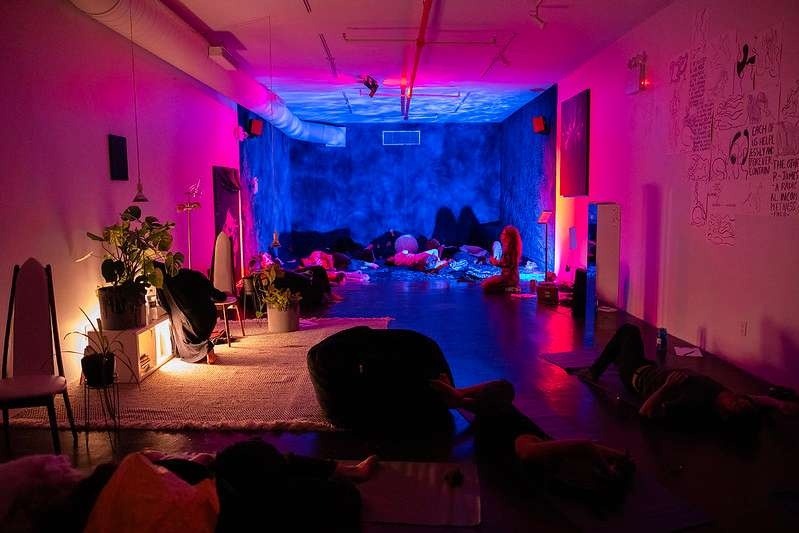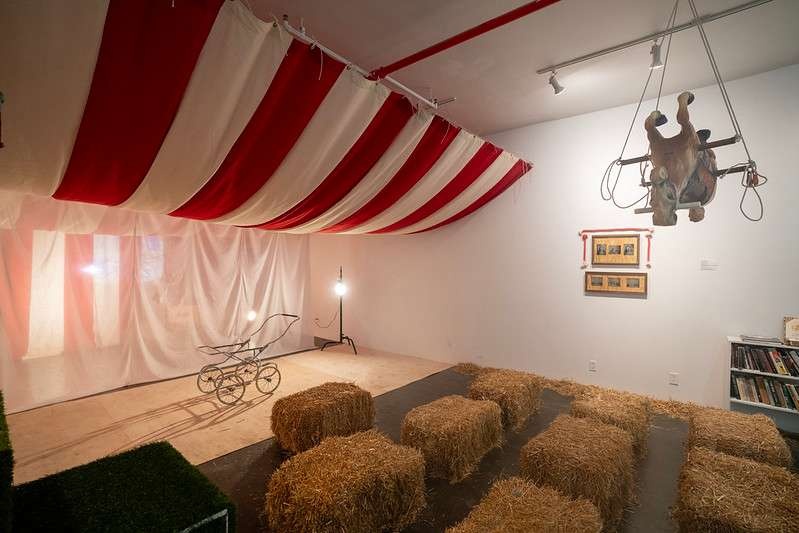The concept of memory demonstrates that time is not absolute, and that subjective temporal experience often dominates over objectified linear mechanical time. Memories are crystallized into our own private space-times, ones primarily informed by our personal perspectives and experiences. This facet of memory—its flexibility and fluidness between our interior lives to our exterior realities, its ability to be invoked by our encounters with particular objects, sounds, images, smells—accounts for the fundamentally different but interconnected experiences, temporalities, and memories of Jamaica between Christopher Udemezue and his mother Angelyn McQueen. As Christopher explores in his Recess session Duppy, these tensions and contradictions in remembrance had the power, at least temporarily, to keep him away from yard, Jamaican patois for home, drawing unseen borders, barriers, and enclosures around his sense of safety, identity, belonging. On the part of Angelyn, she carried a sense of foreboding, future trauma, and high potentialities of violence with his desire to return to yard to visit, telling him don’t try to find too much comfort there, while his own memories of time there were colored with feelings of warmth and comfort.
These tensions in remembrance between Christopher and Angelyn underscore the ways in which memory and time are inextricably interlaced with location and object. Time, experience, and episodic memory is wound up in the places we call home, the objects that inhabit them, and embedded in the land itself. It is ground up in the earth like the soil Christopher used for the Duppy portraits, kneaded into the black resin that colors and sets the found objects, and crystallized in the grains of sand incorporated into the works. It is curled and bent into the edges of frames that store sound and energy. Found objects, long beyond their first life, become artifacts of memory and meaning, having the ability to bear witness to pasts become futures.
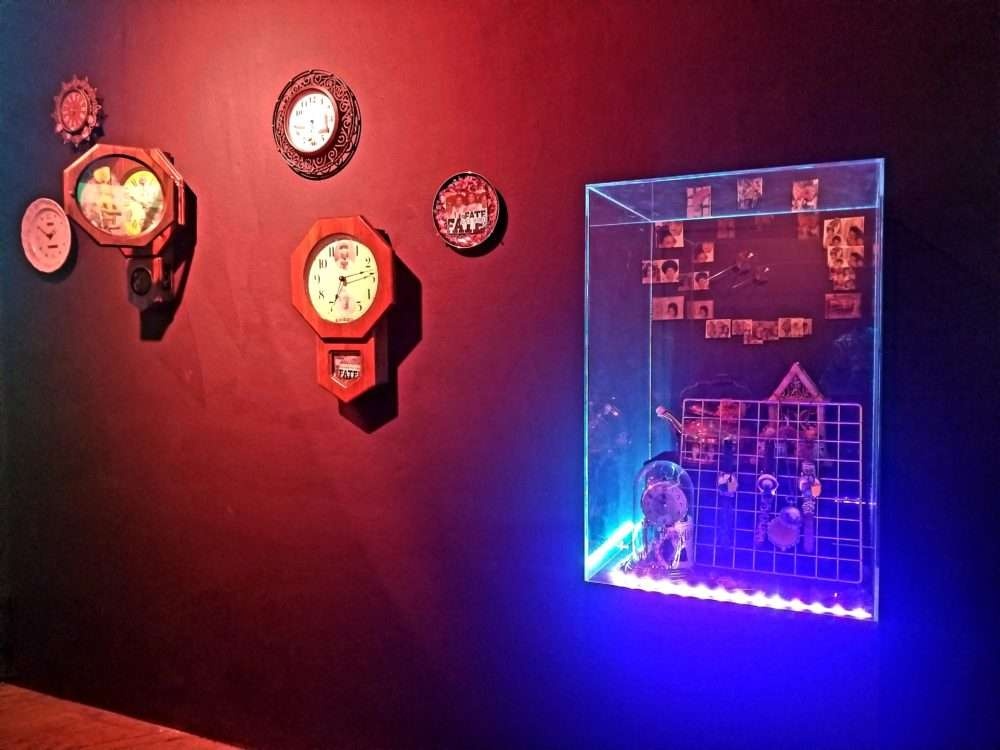

Dismantling the Master’s Clock[work Universe] image from Phillips’ Black Womxn Temporal Portal Project
Throughout an interview Christopher recorded with his mother, I hear sounds of dishes and silverware clanging, doors creaking, a minute or two of unsolicited Christmas music, all providing a soundscape to Angelyn’s weaving of past memory and future speculation. This mundane soundscape of home helps to fill out the dimensions, conjuring a 4-D holographic space in my mind where I am in the room at the table where they are interviewing, and from that kitchen space I am transported back and forth through time and location to Angelyn’s childhood home in Kingston, to the airport in New York where she encountered her mother Daphne again for the first time in years and they did not immediately recognize each other, and as her spirit body journeyed with Christopher as he traveled in the relative present.
Duppy Dead Town is where people go when life boof them, when hope left them and happiness cut she eye ‘pon them and strut away. Duppy dead people drag them foot when them walk. The food them cook taste like burial ground ashes. Duppy Dead people have one foot in the world and the next one already crossing the threshold to where the real Duppy-them living. – Nalo Hopkinson, Midnight Robber
In the interview, they return to the idea of the duppy, a patois word in Jamaica and other Caribbean folklore for an evil ghost or malevolent spirit.
Troubling the Westernized, colonialist understanding of a duppy as binarized between good/evil and one-dimensional, Christopher’s Duppy engages the specter instead as a manifest long wave form of colonial trauma and terror. In the collective present, the duppy in Duppy is revived as poverty, housing instability, hunger, and dislocation haunting marginalized Afrodiasporan communities. It is this specter’s potential for eruption and harm—those who in Angelyn’s words must steal to live, envious people who will kill and take everything, and those with colonized fear and programmed hatred of queerness—that gives rise to a resonant, intergenerational fear, creating temporal ruptures.


“Standing over me”, 2019 | Christopher Udemezue
”53”x43”
Canvas, acrylic, gold leaf, sand, resin, objects found in Jamaica
As Angelyn reminisced, what emerged was a duppy knotted up with her own memories of feeling afraid, unprotected, and unsafe, often catalyzed by the absence of a maternal figure in her during periods in her life as a child and young teen. During one long stretch of time, she was essentially alone with young siblings in Kingston without her mother or older sister, and after the passing of her maternal grandmother—this is when she describes Jamaica as horrible in parallel to what had theretofore been a comfortable childhood. Later, in an alternative speculative future, she imagines a return to yard as one only possible if mediated by her grandmother’s presence. I’d go live in Jamaica right now if my grandmother was there. Ms. Rose. She would make sure all of us were safe. Feelings of warmth, security, love, comfort, and home were relayed by Angelyn specifically in connection to being reunited with the maternal and feminine figures in her life. Angelyn goes on to describe how she offers her own spirit as a form of maternal protection, allowing her to follow Christopher and help keep him safe when he is traveling:
I always ask for the protection for you. If you remember when you went to Mexico…when you went and I got that deep, because it’s like my spirit will follow you and if I lie down to sleep, then that’s trouble coming cuz I’m following you, no? When you call me and tell me that you wasn’t coming, I already see what was gonna happen to you. You wanted to spend extra time. I already seen it.
Angelyn is speaking nimbly here of a form of voluntary temporal displacement: her corporeal body in one place while her spiritual body, entangled with Christopher’s, is following him to enable her to offer a form of protection and home. There is an instantaneous form of communication between them made possible only by entanglement, whereby she would know immediately if her son was facing trouble while traveling, or even ahead of his own conscious awareness.
I frequently use the concept of Black womanist temporalities in my work to create and analyze Afrodiasporan temporal landscapes in Black speculative fiction with Black women. Black womanist temporalities emphasize matrilineal or matri-curvature timelines that are feminine and communally-generated, and in which personal, familial, and communal space-times are enmeshed. Black womanist temporalities divine the experiences of our great + grandmothers as fused into our bodies, providing a highway of sorts upon which we can travel backward into their times, their memories, their experiences. The island of Willow Springs in Gloria Naylor’s novel Mama Day (1988) is an example of a communally-generated, non-linear, Black womanist temporality where the future emerges into the past by way of dreams, omens, prophecies, and symbols, while the past is a space of open possibility, speculation, and active revision by matrilineal descendants of multiple generations of people. The outside world’s attempts to gentrify both the physical and temporal landscapes of Willow Grove is met with fierce and radical resistance from the residents and the island itself.


Aunt Ginny Clock and Temporal DIsruptors Watches from Phillips’ Black Womxn Temporal Portal Project
Black womanist temporalities are a way to understand what produces a feeling of home, rootedness, and protection amalgamated with Angelyn’s memories of her maternal figures and with her own spiritual body, and conversely, how the absence of such can transform a place and time into a spooky site of absence, longing, and danger where the duppy may haunt. And perhaps it is how the duppy space-time was disrupted when he did finally visit Jamaica—Angelyn was by his side the entire time, intersplicing yard temporalities with Christopher’s event of return:
With me seeing you going to Jamaica, even though I’m with you, people think this is strange but spirit is a really strong thing. I’m going to be following you and if there’s any danger. I’m going to feel it from here before you get it there. I just pray to God that when I—well you should call me, and I say come on home, I just want you to get up and come, because that’s what it’s going to be.
In Afrodiasporan and Black womanist temporalities, we understand non-linear cycles as having no conceivable end, with the ability to shift directions and spiral along new paths and where information can be added or revised. We hold the times and memories of our mothers and grandmothers, interwoven into the strands of our DNA. They are everywhen we will be, been everywhen we are. There is never a wrong time on the mother curve/motherline. On the motherline lies the possibility of the event of conquering the duppy, even if we have to repeatedly traverse the territory where the duppy haunts since time on the motherline is non-linear.
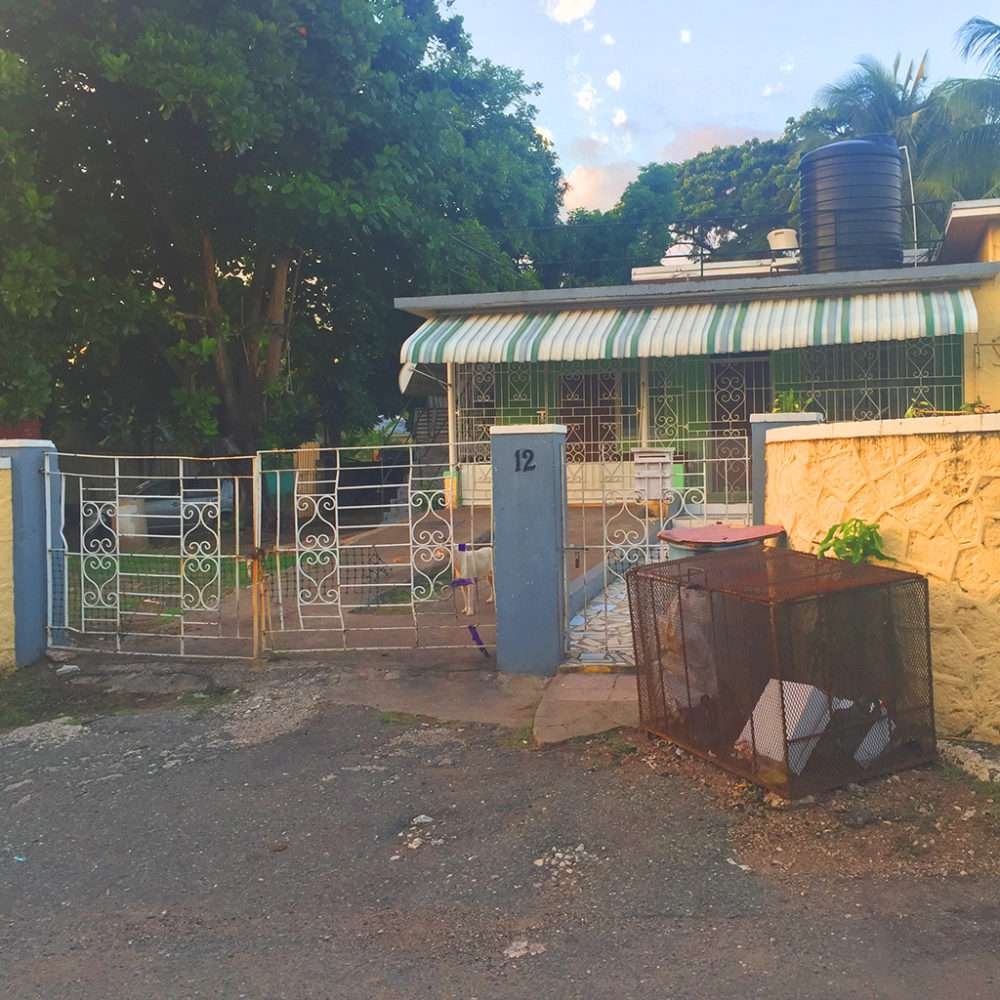

The gate of a home in Jamaica | Image Courtesy of Christopher Udemezue
The word nostalgia derives from a sickness of home, from the trauma and longing one feels after being artificially and involuntarily ripped from your environment. Originally classified as a disease, according to etymonline.com, by 1830s the word was used of any intense homesickness: that of sailors, convicts, African slaves. Its etymology is intimately tied to experiences of displacement, of being pushed out of or torn away from a place where one’s memories and emotions are resonant and rooted in a specific proximity of locality and time. We can understand nostalgia’s nature as ultimately epigenetic, able to be passed intergenerationally, and in the case of Duppy, we understand it to inform Christopher’s complex longings and projections of nostalgia towards yard.
If we are able to inherit our mothers’ and our grandmothers’ traumas, their duppies, their earned fears, is it our responsibility to heal both them and ourselves? Does healing imply a reaching back, a curve on the timeline that wraps back around through the generations? Can we also inherit our mothers’ joyful moments, their definitions of home?
As a kid everything is a lifetime when you’re not home with your family.
Dislocation or displacement from one’s home or community is most often framed in the context of spatial inequity; it is typically not seen as a matter of dislocation from time or as a temporal inequity. In the act of dis-placing, a rupture in both space and time occur, one which allows for the Duppy to spill over into the present, to bring with it a non-localized trauma.
Because of the economic and political landscape in Kingston—such that it was not a place where Angelyn’s mother Daphne could live, work, and support her family—two generations of girls and women, though ultimately reunited, were dis-placed from space, time, and family. Temporal inequity is present here in the necessity of a single mother and her “working age” children to all have jobs in order to satisfy US immigration requirements, and in order to support her family back home. It is the “work like a Jamaican” trope of Caribbean folks portrayed laboring around the clock at multiple jobs, only absent the critical context of immigration labor standards as a form of temporal oppression, and temporal assimilation into colonial-capitalist “time is money” culture as means of economic survival. (See, for example, In Living Color’s “Hey Mon” recurring skit.)
Marginalized Black communities the world over are plagued by material, spatial, and temporal inequities, with many Black communities forced to occupy temporal ghettos as they do physical ones (Rifkin 191). It is our so-called failure to accelerate quickly enough on the progressive, capitalist timeline and arrive quickly enough into the futures envisioned by the state, that often keeps marginalized Black people locked into a narrow temporal present bereft of tools, technologies, and resources.
On the other hand, it is within these temporal ghettoes that we find Black womanist temporalities enacted out of necessity to ensure our survival into the future(s). We find ourselves in the now-here due to the daily rituals of our grandmothers and mothers, where they created time, space, and home from nothing—a feat simultaneously mundane and as crucial as the Big Bang. These everyday miracles of life as we know it are summoned and honored in Duppy’s space-time at Recess.
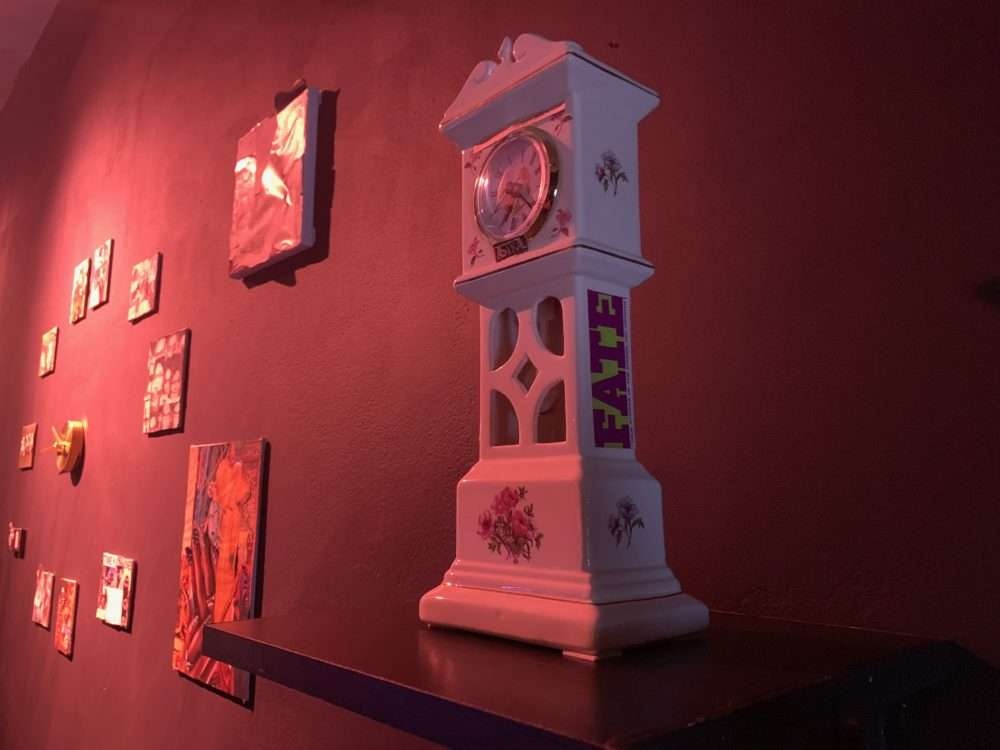

Grandmother Clock 001 from Phillips’ Black Womxn Temporal Portal Project
Through the recovery and binding of ancient and new Afrodiasporan tools, resources and technologies, we can construct portals, time capsules, and temporal displacement devices that help us define, find, create, escape, and/or return home. Duppy is such a portal, one operating with principles of space-time that gives us a window into visions, rhythms, textures, artifacts, temporalities of yard constructed from the dance of intertwining strands of ancestral, maternal, communal, and personal memory.
References
About the artist
Rasheedah Phillips
Rasheedah Phillips is an artist, author, community activist, and lawyer based in Philadelphia. She is the creator of The Afrofuturist Affair and, together with Camae Ayewa, created Black Quantum Futurism multidisciplinary artist collective. Phillips is the Senior Advocate & Resources Attorney at Shriver Center on Poverty Law and a founding member of the Metropolarity Queer Sci-Fi collective. She is the author of Recurrence Plot (and Other Time Travel Tales)(2014), and of two anthologies of experimental essays from Black visionary writers called Black Quantum Futurism: Theory & Practice Vol. I (2015) and Space-Time Collapse I: From the Congo to the Carolinas (2016).
Explore/Archive
See allDecember 2025
The INSTITUTE FOR TRANSHUMANIST CEPHALOPOD EVOLUTION and Learning from Octopuses
Barbara London
Barbara London reflect's of Miriam SImun's INSTITUTE FOR TRANSHUMANIST CEPHALOPOD EVOLUTION
October 2025
streamlined reflections, courtesy of noise canceling headphones
Gabrielle Rucker
Gabrielle Rucker reflects on the radical intimacy and auditory life at the heart of Deli Radio
July 2025
Tell My Jockey: CUNTRY’s Discourse From the Horse’s Mouth
Ericka Pérez
Assembly fellow Ericka Pérez reflects on clowning, resistance, and CUNTRY’s radical refusal to perform.
